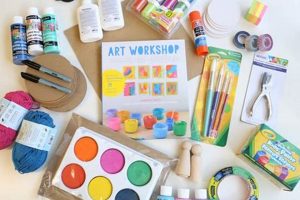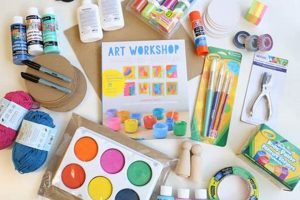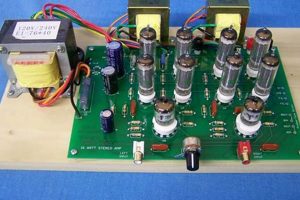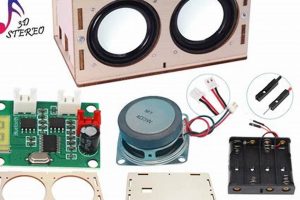Products marketed as “do-it-yourself” dental prosthetics represent an attempt to create artificial teeth replacements at home, bypassing professional dental services. These kits typically include materials like moldable plastics or resins, along with instructions for creating a customized dental appliance. The resultant product aims to mimic the appearance and function of natural teeth, albeit constructed without the precision and expertise of a trained dental professional.
The purported advantage of these alternative methods often centers on cost savings and immediate accessibility. Individuals who cannot afford professional dental care or face delays in obtaining appointments might view these kits as a quick, affordable solution. Historically, the desire for readily available dental replacements has driven innovation and experimentation, though modern dentistry emphasizes the long-term health implications of improperly fitted prosthetics.
The subsequent discussion will explore potential risks associated with creating dental appliances without professional oversight. Furthermore, the article will contrast the characteristics of these alternatives with the benefits and procedures involved in obtaining professionally manufactured and fitted dentures or partials from a qualified dentist. The long-term implications for oral health will also be considered.
Important Considerations Regarding At-Home Dental Prosthetics
This section outlines crucial factors to consider before using a “do-it-yourself” dental prosthetic kit. Prioritizing oral health and long-term well-being is paramount when contemplating such solutions.
Tip 1: Assess the Risks: Understand the potential for damage to existing teeth, gums, and jawbone structure. Ill-fitting dental appliances can cause irritation, infection, and accelerated bone loss.
Tip 2: Consider Professional Alternatives: Explore all available professional dental options. Consult with a dentist to discuss affordable treatment plans, payment options, or community dental programs.
Tip 3: Evaluate Material Safety: Research the composition of the kit’s materials. Ensure the materials are biocompatible and free from harmful substances that could leach into the oral cavity.
Tip 4: Understand Fitting Limitations: Recognize that at-home molding techniques cannot replicate the precision of professional dental impressions. This lack of precision can lead to an uncomfortable and potentially damaging fit.
Tip 5: Prioritize Hygiene: Maintain meticulous oral hygiene practices. Even with a professionally fitted prosthetic, proper cleaning is essential to prevent bacterial growth and infection; this is even more critical with an at-home appliance.
Tip 6: Seek Professional Evaluation: If you choose to use a “do-it-yourself” kit, schedule a consultation with a dentist for a professional evaluation of the appliance and its impact on your oral health.
Tip 7: Be Aware of Long-Term Costs: Weigh the immediate cost savings against the potential for future dental problems and the associated expenses for professional treatment to correct any damage.
In summary, informed decision-making regarding dental replacements requires careful consideration of potential risks and benefits. Professional dental care remains the gold standard for ensuring optimal oral health and prosthetic fit.
The following section will address potential complications and the importance of long-term oral health maintenance when considering or using at-home dental prosthetic solutions.
1. Material Biocompatibility and DIY False Teeth Kits
Material biocompatibility is a foundational requirement for any substance intended for use within the human body. In the context of “do-it-yourself” dental prosthetics, this characteristic assumes critical importance due to the direct and prolonged contact of the prosthetic material with oral tissues.
- Tissue Irritation and Allergic Reactions
Non-biocompatible materials can elicit inflammatory responses in the oral mucosa, leading to irritation, swelling, and discomfort. Some individuals may experience allergic reactions to specific components within the “do-it-yourself” kit, manifesting as contact dermatitis or more severe systemic reactions. Unlike professionally manufactured prosthetics where materials undergo stringent biocompatibility testing, “do-it-yourself” kits may lack sufficient validation, increasing the risk of adverse reactions.
- Leaching of Toxic Substances
Certain materials, particularly plastics and resins used in “do-it-yourself” dental kits, may leach harmful chemicals into the oral cavity over time. These substances can include monomers, plasticizers, or other additives that are not fully polymerized or chemically stable. Chronic exposure to these leached chemicals can pose potential health risks, including systemic toxicity and potential carcinogenic effects. Professional dental materials are subject to regulations and quality control measures to minimize or eliminate this risk.
- Bacterial Colonization and Biofilm Formation
The surface properties of the prosthetic material influence bacterial adhesion and biofilm formation. Non-biocompatible materials may exhibit rough or porous surfaces that promote bacterial colonization, increasing the risk of oral infections, such as gingivitis, periodontitis, and candidiasis. These infections can compromise the health of the surrounding tissues and potentially lead to tooth loss or systemic complications. Professionally fabricated prosthetics often incorporate surface treatments or materials that resist bacterial adhesion.
- Long-Term Impact on Oral Health
The cumulative effects of using a non-biocompatible “do-it-yourself” dental prosthetic can significantly impact long-term oral health. Chronic inflammation, tissue damage, and bacterial infections can accelerate bone loss, compromise the integrity of adjacent teeth, and increase the need for more extensive and costly dental treatments in the future. The absence of professional monitoring and management further exacerbates these risks.
The selection of biocompatible materials in professionally manufactured dental prosthetics is guided by rigorous standards and clinical evidence. In contrast, “do-it-yourself” kits often prioritize affordability and ease of use, potentially compromising material safety and biocompatibility. Consumers should carefully evaluate the material composition of any “do-it-yourself” kit and be aware of the potential risks associated with using non-biocompatible substances in the oral cavity. Consulting a dental professional is crucial for assessing the suitability of any dental prosthetic material and ensuring optimal oral health.
2. Fitting Accuracy in DIY False Teeth Kits
The precision of fit is paramount in any dental prosthetic, influencing comfort, function, and long-term oral health. With “do-it-yourself” false teeth kits, achieving an accurate fit presents significant challenges due to the inherent limitations of the process and materials involved.
- Impression Technique Limitations
Professional dental impressions utilize specialized materials and techniques to capture intricate details of the oral anatomy. “Do-it-yourself” kits typically rely on simplified impression methods, often employing thermoplastic materials or alginate alternatives. These materials may not accurately replicate the fine structures of the gums and underlying bone, leading to inaccuracies in the resulting prosthetic fit. The absence of professional guidance in impression taking further exacerbates this issue.
- Material Distortion and Shrinkage
The materials used in “do-it-yourself” kits are prone to distortion and shrinkage during the molding and curing processes. These dimensional changes can compromise the accuracy of the final prosthetic, creating gaps between the appliance and the oral tissues. Such inaccuracies can lead to discomfort, food impaction, and increased risk of infection.
- Lack of Occlusal Adjustment
A properly fitted dental prosthetic must integrate seamlessly with the existing dentition, ensuring proper occlusion (the way teeth come together). Professional dentists carefully evaluate and adjust the occlusion to prevent excessive stress on the teeth and jaw joints. “Do-it-yourself” kits typically lack the tools and expertise necessary to achieve accurate occlusal adjustment, potentially leading to temporomandibular joint (TMJ) disorders and accelerated wear of the natural teeth.
- Gingival Irritation and Tissue Damage
An ill-fitting dental prosthetic can exert excessive pressure on the gums and underlying bone, causing irritation, inflammation, and eventual tissue damage. Chronic irritation can lead to gingivitis, periodontitis, and bone resorption, compromising the long-term stability of the remaining teeth. The lack of professional fitting and monitoring with “do-it-yourself” kits increases the risk of such complications.
The challenges associated with achieving accurate fitting in “do-it-yourself” false teeth kits underscore the importance of professional dental care. While the appeal of affordability and convenience may be tempting, the potential for long-term oral health complications warrants careful consideration and consultation with a qualified dentist. A professionally fabricated and fitted dental prosthetic offers superior accuracy, comfort, and long-term stability, minimizing the risk of adverse outcomes.
3. Potential for Infection
The use of a “do-it-yourself” false teeth kit introduces a tangible risk of oral infection. The process, often conducted in non-sterile environments, inherently increases the likelihood of bacterial contamination of the materials used. Unlike professionally crafted dental prosthetics, “do-it-yourself” kits lack the regulated fabrication process, sterilization procedures, and biocompatibility assessments crucial for mitigating infection risk. The rough surfaces and imprecise fit common with these homemade appliances create ideal breeding grounds for bacteria and fungi, leading to conditions such as gingivitis, periodontitis, and candidiasis. For example, an improperly cleaned “do-it-yourself” denture can harbor food particles and promote the growth of anaerobic bacteria, contributing to halitosis and more severe periodontal issues. A poorly fitting appliance can also cause ulcerations and inflammation of the oral mucosa, creating entry points for opportunistic pathogens.
The impact of this potential infection extends beyond the oral cavity. Chronic oral infections have been linked to systemic health problems, including cardiovascular disease, diabetes complications, and respiratory infections. Patients with compromised immune systems are particularly vulnerable to these risks. The lack of professional oversight in “do-it-yourself” dental applications also means that early signs of infection may go unnoticed or misdiagnosed, delaying appropriate treatment and potentially leading to more severe complications. Furthermore, attempts to self-treat infections arising from “do-it-yourself” dental appliances can result in inappropriate antibiotic use and the development of antibiotic-resistant bacteria, further complicating treatment options.
In summary, the elevated potential for infection constitutes a significant concern associated with “do-it-yourself” false teeth kits. The non-sterile environments, material limitations, and lack of professional supervision contribute to an increased risk of oral and systemic health complications. While the kits may seem like an affordable or convenient alternative to professional dental care, the associated risks and potential long-term costs should be carefully considered. Prioritizing professional dental care and proper oral hygiene remains paramount for safeguarding oral health and minimizing the risk of infection when tooth replacement is needed.
4. Long-term damage risk
The utilization of “do-it-yourself” dental prosthetics carries inherent risks, with the potential for long-term damage to oral health being a primary concern. The absence of professional evaluation, precise fitting, and biocompatible materials elevates the probability of irreversible harm to the teeth, gums, and underlying bone structure.
- Accelerated Bone Resorption
An ill-fitting appliance can exert uneven pressure on the alveolar ridge, leading to accelerated bone resorption. This process, if left unchecked, diminishes the support for remaining teeth and complicates future prosthetic options. In professionally fitted dentures, even with proper fitting, bone loss is a factor; however, the rate of bone loss is considerably minimized with careful attention to optimal fit and regular monitoring. With at-home solutions, the chances of uneven pressure and accelerated bone loss rise significantly.
- Temporomandibular Joint (TMJ) Disorders
Improper occlusion resulting from a poorly designed or ill-fitting “do-it-yourself” prosthetic can disrupt the natural biomechanics of the jaw, predisposing individuals to TMJ disorders. Symptoms may include jaw pain, headaches, clicking or popping sounds in the jaw joint, and difficulty chewing. Correcting TMJ disorders often requires extensive and costly professional intervention.
- Damage to Adjacent Teeth
A poorly fitted prosthetic can place undue stress on adjacent teeth, leading to enamel erosion, tooth mobility, and even tooth loss. Clasps or other retention mechanisms in “do-it-yourself” partial dentures may contribute to abrasion and weakening of supporting teeth. This risk is minimized with professionally designed and fitted partials that are carefully assessed for appropriate support and occlusion.
- Increased Risk of Oral Cancer
Chronic irritation from an ill-fitting prosthetic has been implicated as a potential contributing factor in the development of oral cancer. While the direct causal link is not definitively established, persistent in
flammation and tissue damage may increase the risk of malignant transformation. Professional monitoring and early detection are crucial for managing this potential risk, a benefit absent in “do-it-yourself” applications.
The aforementioned risks highlight the potential for significant and irreversible damage arising from the use of “do-it-yourself” false teeth kits. While the immediate cost savings may appear attractive, the long-term consequences for oral and overall health often outweigh any perceived benefits. Professional dental care remains the gold standard for ensuring safe and effective tooth replacement, minimizing the risk of complications and preserving oral health.
5. Professional consultation absent
The defining characteristic of a “do-it-yourself” false teeth kit is the absence of professional dental consultation. This absence forms the foundational difference between these kits and professionally fabricated dental prosthetics. The lack of professional involvement eliminates essential steps crucial to ensuring a safe, functional, and biocompatible dental appliance. Without a dentist’s assessment, pre-existing oral health conditions, such as periodontal disease or underlying bone deficiencies, remain unaddressed, potentially exacerbating these issues. For instance, an individual with undiagnosed bone loss may attempt to use a “do-it-yourself” kit, only to find that the appliance lacks adequate support, leading to further bone resorption and eventual failure of the prosthetic. This absence also means there is no assessment of the individual’s bite or occlusion, which is vital for preventing temporomandibular joint disorders and uneven stress on remaining teeth. Real-life examples consistently demonstrate that individuals who bypass professional consultation often experience discomfort, poor fit, and accelerated oral health decline.
Further analysis reveals that the “professional consultation absent” factor impacts various aspects of the “do-it-yourself” approach. For example, the selection of appropriate materials becomes a significant concern. Dentists undergo extensive training to understand the properties of various dental materials and their suitability for individual patient needs. In contrast, users of “do-it-yourself” kits rely on limited information and may select materials that are not biocompatible or durable, leading to allergic reactions or premature failure of the appliance. Practical application of this understanding involves recognizing that the perceived cost savings of a “do-it-yourself” kit are often offset by the potential for costly future dental treatments required to address complications arising from the absence of professional oversight.
In summary, the absence of professional consultation represents a critical deficiency in “do-it-yourself” false teeth kits, impacting material selection, fitting accuracy, and long-term oral health outcomes. While the allure of convenience and affordability may be strong, the potential for irreversible damage necessitates careful consideration. The decision to forego professional consultation carries significant risks, underscoring the importance of informed decision-making and prioritizing expert guidance when addressing tooth replacement needs. The ethical challenges associated with marketing such kits without adequately informing consumers of these risks remain a topic of ongoing debate within the dental community.
Frequently Asked Questions About DIY False Teeth Kits
This section addresses common inquiries and misconceptions regarding “do-it-yourself” dental prosthetic solutions, providing factual information and highlighting potential risks.
Question 1: Are “do-it-yourself” false teeth kits a safe alternative to professional dentures?
The safety of “do-it-yourself” kits is questionable. These kits lack professional evaluation and fitting, increasing the risk of oral infections, gum irritation, bone loss, and damage to existing teeth. Professional dentures are fabricated and fitted by qualified dentists, minimizing these risks.
Question 2: Can “do-it-yourself” false teeth kits provide a comfortable and functional fit?
The fit achieved with “do-it-yourself” kits is often imprecise and uncomfortable. Professional dentures are custom-made to fit the individual’s unique oral anatomy, ensuring optimal comfort and function for chewing, speaking, and maintaining facial structure.
Question 3: What materials are used in “do-it-yourself” false teeth kits, and are they biocompatible?
The materials used in “do-it-yourself” kits may vary, and their biocompatibility may not be thoroughly tested. Some materials may leach harmful chemicals into the oral cavity or cause allergic reactions. Professionally fabricated dentures utilize biocompatible materials that meet stringent safety standards.
Question 4: What are the long-term consequences of using “do-it-yourself” false teeth kits?
Long-term consequences may include accelerated bone loss, temporomandibular joint (TMJ) disorders, damage to adjacent teeth, and increased risk of oral infections. These complications can necessitate costly and extensive dental treatment to correct.
Question 5: Can “do-it-yourself” false teeth kits be easily adjusted if they become uncomfortable or ill-fitting?
Adjusting “do-it-yourself” kits is difficult and often impossible due to the limitations of the materials and the absence of professional tools and expertise. Professional dentures can be adjusted by a dentist to ensure continued comfort and proper fit over time.
Question 6: Are there any circumstances in which “do-it-yourself” false teeth kits might be acceptable?
“Do-it-yourself” kits are generally not recommended as a long-term solution. In emergency situations or temporary circumstances where professional dental care is immediately unavailable, they might serve as a temporary placeholder. However, professional evaluation and treatment should be sought as soon as possible.
These FAQs highlight the significant risks associated with “do-it-yourself” false teeth kits. Professional dental care remains the safest and most effective approach to tooth replacement.
The next section presents a comparative analysis of “do-it-yourself” kits versus professionally fabricated dentures, providing a comprehensive overview of the benefits and drawbacks of each option.
Conclusion
This exploration of “diy false teeth kit” alternatives has illuminated inherent risks and limitations. The absence of professional oversight during fabrication and fitting elevates the potential for complications. Material biocompatibility, fitting accuracy, and long-term oral health are consistently compromised in contrast to professionally crafted dental prosthetics. These kits may present an illusion of immediate cost savings but frequently lead to more extensive and expensive corrective treatments.
Therefore, informed decision-making regarding tooth replacement necessitates careful consideration of the factors discussed. Prioritizing professional dental care remains paramount for safeguarding oral health and mitigating the long-term adverse consequences associated with “do-it-yourself” solutions. Individuals seeking dental prosthetics are urged to consult with qualified dental professionals to explore appropriate and safe treatment options tailored to their specific needs.







